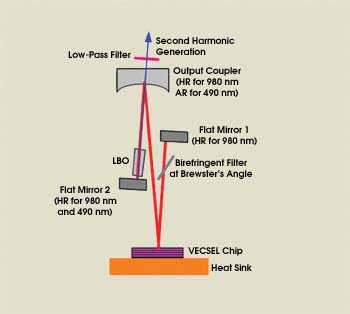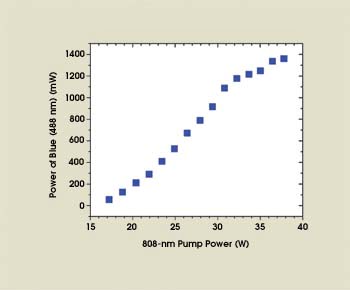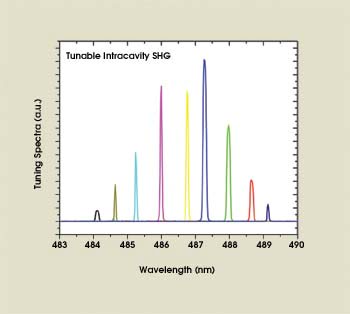
VECSEL Generates Watt-Level Blue-Green Output
Intracavity second-harmonic generation produces 1.3 W at 488 nm.
Breck Hitz
Compact and efficient blue-green lasers have numerous potential uses, including in displays, data storage, spectroscopy and biomedical applications. Recently, a collaboration of researchers at the University of Arizona and at Areté Associates, both in Tucson, and at Philipps Universität Marburg in Germany demonstrated an intracavity frequency-doubled vertical external-cavity, surface-emitting laser (VECSEL) whose watt-level blue-green output could be tuned several nanometers around its peak output at 488 nm.
The researchers had previously demonstrated efficient spectral narrowing by inserting a birefringent filter into their VECSEL (Photonics Spectra, March 2006, p. 24).
In the current work, they took advantage of the narrow bandwidth by adding a lithium triborate (LBO) crystal to the resonator to frequency-double the laser’s output. They arranged the resonator in a Z-configuration, with the VECSEL chip serving as one of the folding mirrors (Figure 1).

Figure 1. The spherical output mirror focused the intracavity beam to an ~45-μm spot inside the 3 × 3 × 10 mm3 lithium triborate (LBO) crystal.
The active region of the VECSEL chip consisted of 14 compressively strained InGaAs quantum wells, with the geometry arranged so that an antinode of the resonator’s standing wave coincided with each of the wells.
The investigators took careful steps to ensure that the angle of incidence on the other folding mirror — a spherical mirror with a 7.5-cm radius of curvature that also served as the output coupler for the second harmonic — was small enough to introduce negligible astigmatism. By focusing the 808-nm pump radiation to an ~600-μm spot in the VECSEL chip, they came close to matching the ~540-μm TEM00 beam size. The birefringent filter not only controlled the laser’s bandwidth, but because it was oriented at Brewster’s angle, it also polarized the laser for type-I phase-matching in the LBO crystal.
But the researchers had to use available mirrors on the resonator, and their reflectivities were not optimal for the experiment. The output mirror, which ideally would have had maximum reflectivity at the fundamental wavelength (976 nm) and maximum transmission at the second harmonic (488 nm), in reality had reflectivities of ~99 percent and ~30 percent at the two wavelengths, respectively.
The less-than-maximum reflectivity at the fundamental wavelength reduced the cavity Q, and the too-high reflectivity at the second harmonic deflected nearly a third of the blue-green light into the VECSEL chip, where it was absorbed. Likewise, the mirror behind the LBO crystal (flat mirror 2 in Figure 1) ideally would have had maximum reflectivity at both the fundamental and second harmonic.

Figure 2. The second-harmonic, 488-nm output was slightly more than 1.3 W. After calculating the circulating power based on the leakage through a 99 percent reflecting mirror, the researchers figured the intracavity conversion efficiency to be ~1.3 percent.
In reality, the mirror had maximum reflectivity at the fundamental, but only 80 percent at the second harmonic, so a significant portion of the second harmonic leaked through this mirror and was lost.
Despite these less-than-ideal experimental conditions, the researchers still observed more than 1.3 W of second-harmonic output at 488 nm (Figure 2). They measured 1 W of fundamental power leaking through the output mirror and, based on that mirror’s nominal 1 percent transmission, surmised that the intracavity circulating power was roughly 100 W. Thus, the second-harmonic conversion efficiency was ~1.3 percent.

Figure 3. In this series of scans, the researchers continuously tuned the second-harmonic output ~5 nm, while maintaining a narrow bandwidth.
When the LBO crystal was absent from the resonator, the researchers could tune the fundamental wavelength across ~20 nm by adjusting the birefringent filter. The insertion loss of the crystal, however, reduced this tunability to ~10 nm.
To tune the second harmonic, they adjusted both the birefringent filter and the phase-matching angle of the LBO crystal. Because the mirror behind the LBO crystal was flat, this angle tuning could be accomplished with no additional alignment of the resonator. They tuned the second harmonic across nearly 5 nm, maintaining a narrow bandwidth across the entire range (Figure 3).
Applied Physics Letters, June 19, 2006, 251117.
Published: September 2006